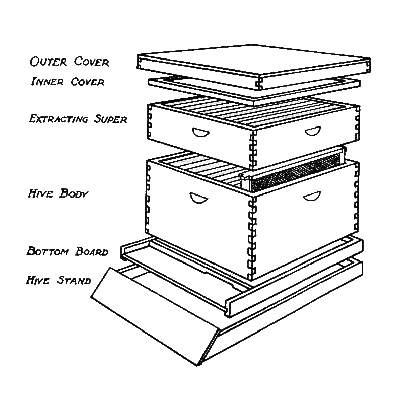Apiculture

Figure 1

A drawing on the wall of a cave in eastern Spain may be the most ancient record of the association between humans and honey bees. The drawing, perhaps as much as 9000 years old, depicts a human figure scaling a ladder to gather honeycomb from a hive of wild bees (Figure 1). Other cave paintings from the same era have been found in Natal and Zimbabwe, South Africa, suggesting that a knowledge of bees and honey may have been widespread among primitive tribes of hunter-gatherers.

Figure 2
Robbing wild beehives is a risky venture, and although it is still practiced in some parts of the world, humans eventually found better ways to manage bees and harvest honey. The first steps toward modern apiculture (the art and craft of beekeeping) probably involved tending wild hives or providing natural cavities (such as hollow logs) for the bees to use as nest sites. By 4000 BC, people in China and Egypt had learned to keep bees in artificial hives made of pottery or woven from straw (Figure 2). In time, they also learned to capture swarms, to pacify the bees with smoke from a torch, to replace an aging queen with a younger one, and to protect a hive from predation and disease. But despite much experimentation, the hives themselves were little more than hollow cavities where bees were encouraged to build their honeycomb. All such hives, many of which are still in use throughout the world, share a common disadvantage: the comb must be damaged or destroyed in order to inspect the brood (larvae and pupae) or remove the honey. Various methods have been used to minimize this damage, but none were entirely successful at preventing it.

Rev. Langstroth
The era of modern apiculture began in 1851 when the Rev. L. L. Langstroth, a Pennsylvania minister and part-time beekeeper, designed and built the first beehive with frames that could be easily removed to gather honey without disturbing the main brood of the hive. This achievement was based largely on Langstroth’s own discovery that bees leave a space of precisely 10 mm (3/8 inch) between each section of their honeycomb — instinctively sealing smaller gaps with propolis (bee glue) and filling larger ones with more honeycomb. This optimal distance, which has come to be known as the “bee space”, gives worker bees just enough room to move around easily on the comb surface.
 Langstroth’s hive, built so that all structural components would be separated by a 10 mm gap, became the prototype for most of the beehives used in the United States today. A modern hive (right) consists of a rectangular box, called the brood chamber, filled with vertical frames that hang from ledges on opposite sides of the box. Each frame initially contains a beeswax “foundation”, supplied by the beekeeper, on which the bees build their comb to rear brood and store honey. A second box (called a super) rests on top of the brood chamber. It also contains vertical frames with foundation, but it is often separated from the brood chamber by a screen grid, called a queen excluder, that keeps the large-bodied queen from crawling into the super to lay eggs. Workers are small enough to squeeze through the excluder, so they build wax cells and store honey in the frames of the super. A beekeeper can harvest the honey without disturbing the brood by simply opening the top of the hive and pulling frames out of the super.
Langstroth’s hive, built so that all structural components would be separated by a 10 mm gap, became the prototype for most of the beehives used in the United States today. A modern hive (right) consists of a rectangular box, called the brood chamber, filled with vertical frames that hang from ledges on opposite sides of the box. Each frame initially contains a beeswax “foundation”, supplied by the beekeeper, on which the bees build their comb to rear brood and store honey. A second box (called a super) rests on top of the brood chamber. It also contains vertical frames with foundation, but it is often separated from the brood chamber by a screen grid, called a queen excluder, that keeps the large-bodied queen from crawling into the super to lay eggs. Workers are small enough to squeeze through the excluder, so they build wax cells and store honey in the frames of the super. A beekeeper can harvest the honey without disturbing the brood by simply opening the top of the hive and pulling frames out of the super.

